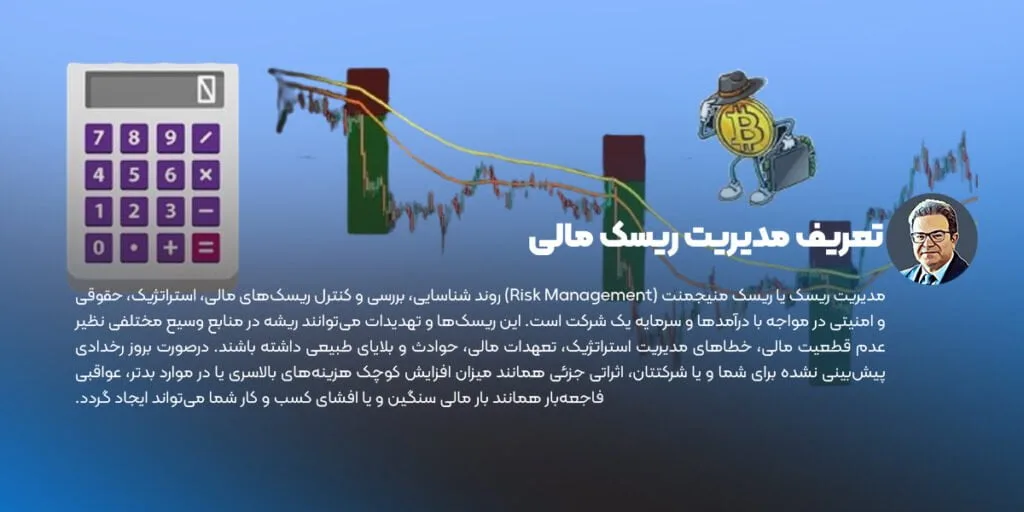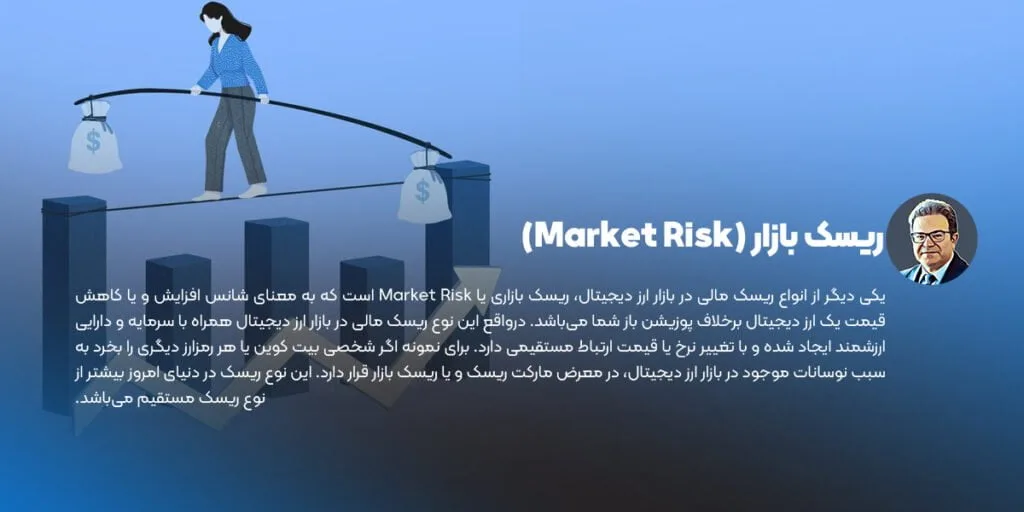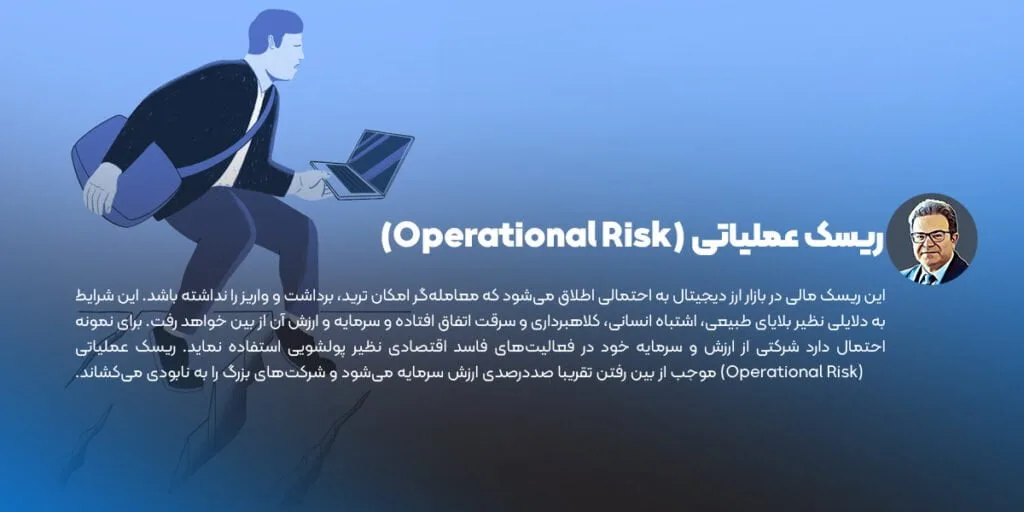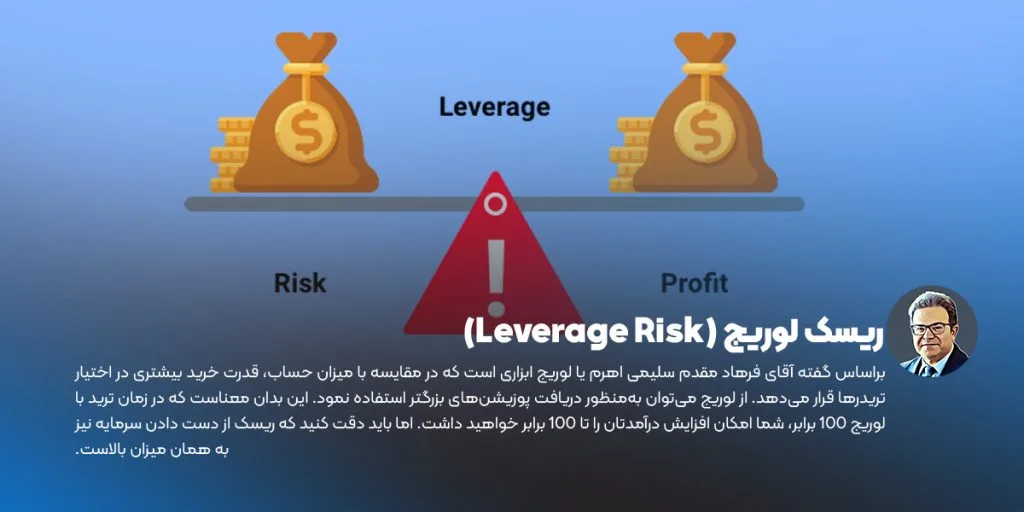Table of Contents
Toggle
English
فارسی (Persian)
Türkçe (Turkish)

Financial risk in the digital currency market and all financial markets means the possibility of negative events occurring in part of the trading process in your desired market. Risk is actually the chance of creating an unfavorable outcome in the transaction, which leads to loss. For example, a 50% risk in a short (sell) position means a 50% chance of a bitcoin price increase and your loss. Therefore, to prevent this from happening, you must be familiar with the risk of investing in digital currency and risk management in the digital currency market.
In fact, due to the extreme fluctuations of the digital currency market and the much higher risk of capital loss in these markets, it is very necessary to be familiar with the types of financial risk and to learn professional capital management.
Do not enter the capital market in all financial markets, including the Bahadur stock market, forex and the new cryptocurrency market, if you do not have the ability to accept losses and bear losses. Another point is that under no circumstances should you enter the hard-earned capital and the result of your hard work into the capital market and other markets. Because if you lose capital, you will suffer a lot of losses.
In the rest of this article, you will get to know the types of financial risk in the digital currency market and the training of risk and capital management in digital currency .
What is financial risk?
Financial risk is actually a risk in which there is a risk of losing capital and any kind of valuable asset. The important point in stating the definition of financial risk and risk of capital loss is that this concept does not mean definite loss. In fact, this risk is a risk that is likely to occur in the future, and it is also called the inherent risk of the market. All financial markets, from the Tehran Stock Exchange to the new cryptocurrency and forex markets, have inherent risks. Therefore, any investment in these markets is exposed to such risks.
My suggestion to people who do not have the financial and mental ability to lose is not to enter the capital market. The capital market is a market that, in its best case, always carries a percentage of risk. Therefore, if you are a risk-averse person, do not enter the capital market at all. Being risk-averse and risk-averse is one of the characteristics of people, and only the capital market will not be a suitable place for investment for risk-averse people.
If you need risk for a change in your financial situation. And believe that you cannot achieve what you want through conservative and normal work, you can accept this risk by training capital management in trading.

Definition of financial risk management
Risk management is the process of identifying, investigating and controlling financial, strategic, legal and security risks in the face of a company’s income and capital. These risks and threats can be rooted in various sources such as financial uncertainty, strategic management errors, financial obligations, accidents and natural disasters. In the event of an unforeseen event for you or your company, minor effects such as a small increase in overhead costs or in worse cases, catastrophic consequences such as a heavy financial burden or exposure of your business can be created.
To reduce these risks, organizations should allocate different resources to minimize, control and monitor the effects of negative events while increasing positive events. Having an integrated, stable and systematic approach to risks can help determine the best way to identify, manage, control and reduce risks.

What is digital currency risk management?
Digital currency risk management is also a systematic solution to identify, evaluate, analyze and develop a plan to improve the risk of investing in digital currency. Investing in digital currencies has inherent risks due to the extreme fluctuations of the cryptocurrency market, which necessitates their careful investigation and management with the help of financial organizations or personally.
As a beginner trader, do not doubt that you will have negative experiences when trading digital currencies. These kinds of experiences mean transactions that are contrary to your expected and desired results. Such as unreasonable price increases, mistakes and other unpleasant events. The risk of investing in digital currency is normal and every trader who steps in this market is aware of it. Crypto futures speculators take more risk due to their tendency to use leverage regularly. Failure to comply with digital currency risk management methods affects your trading balance and can lead to the loss of your entire capital.
Therefore, people who have the necessary financial ability and a risk-averse mentality should be prevented from entering the digital currency markets. Risk management methods in the digital currency industry offer you solutions to reduce risk and reduce your risk of loss as much as possible. In fact, by learning risk and capital management in digital currency, you can protect your capital against the risks and risks of trading.
Types of financial risk in the digital currency market
In technical analysis and fundamental analysis, the trader’s goal is to find the best entry and exit points in the cryptocurrency market and other financial markets. But before accepting the risk of investing in digital currency, which has high volatility, you must first familiarize yourself with these risks and digital currency risk management methods. Therefore, after training capital management in trading and dealing with risk, learning technical analysis helps in making successful transactions and trades. In the following, we mention some of the financial risks of the digital currency market:
Read more: Fundamental analysis
Credit Risk
Credit risk in the digital currency market affects crypto projects. Credit risk is actually the possibility of failure of the development team of a project to fulfill its obligations within the specified period of time. This financial risk in the digital currency market often manifests itself in fraud and theft of the cryptocurrency market. A good example of this was the hack of the Binance exchange in 2018, which led to the theft of $40 million.
In other words, in your daily life, it may have happened to you that you lend an amount to someone and that person never returns your money. Or someone requests money from us, but we cannot ensure that he has the ability to repay the amount or not. These items are the credit risk. In the digital currency market, beginners may decide to give their capital to professional traders due to lack of experience. Assessing whether this person is able to return the capital and earn profit is one of the credit risks in the digital currency market.

Market Risk
Another type of financial risk in the digital currency market is market risk, which means the chance of an increase or decrease in the price of a digital currency against your open position. In fact, this type of financial risk is created in the digital currency market along with capital and valuable assets and is directly related to the change in rate or price. For example, if a person buys Bitcoin or any other cryptocurrency, he is exposed to market risk or market risk due to the fluctuations in the digital currency market. This type of risk in today’s world is more than direct risk.
Market risk management is at the discretion of the investor. But there are also difficulties. For example, after buying bitcoin, the price of bitcoin may drop suddenly and unpredictably, and you will suffer a loss in less than a few minutes. In this case, if the drop in the price of the purchased Bitcoin is greater than the predicted value, you must plan in advance to avoid losses to manage this situation.
Read more: Bitcoin price depends on what factors?!

operational risk
This financial risk in the digital currency market refers to the possibility that the trader will not be able to trade, withdraw and deposit. These conditions have occurred for reasons such as natural disasters, human error, fraud and theft, and the capital and its value will be lost. For example, it is possible that a company uses its value and capital in corrupt economic activities such as money laundering. Operational risk causes the loss of almost 100% of capital value and destroys large companies.

Technology and Security Risk
The blockchain behind digital currencies works as a distributed ledger. In networks such as Bitcoin that use the Proof of Work (PoW) mechanism, high energy consumption by miners is a threat to its widespread adoption.
Read more: How can blockchain security be increased?
Custody Risk
Due to the attractiveness of digital currencies to hackers due to the untraceability of some cryptocurrency activities, fraudsters are trying to gain access to digital currency platforms and accounts by stealing private keys. Custody of digital currencies is done by hot and cold wallets. However, it is also possible to access and hack them.
Cyber security is one of the most challenging issues in various financial organizations due to the need to protect sensitive information, strengthen financial systems against attacks, and prevent unauthorized access. With the ever-increasing growth of technology, security risks and threats have become more and more complex. From today, every financial organization must prevent cyber attacks and unauthorized access to sensitive information and ensure the security of its systems and information.

Exchange Risk
Cases such as server outage, account closure, price manipulation, digital currency price movement to stop loss or loss limit, and connection problems are among the threats related to digital currency exchanges.

Leverage Risk
Leverage is a tool that provides more buying power to traders compared to the amount of the account. Leverage can be used to get bigger positions. This means that when trading with 100x leverage, you will be able to increase your income by 100x. But you should be careful that the risk of capital loss is equally high.
Read more: What is leverage in digital currency?
Liquidity risk
Liquidity risk refers to the possible problems of an organization in fulfilling its short-term financial obligations due to the inability to convert assets into cash without causing significant losses. For example, imagine someone bought 500 units of a cryptocurrency at a rate of $3 per unit. The issue of how quickly the purchased digital currency of this person is sold and liquidated is considered one of the liquidity risks.
It is possible that there will not even be a change in the price of the purchased cryptocurrency. But other traders are not willing to buy or sell this cryptocurrency at the rate of $3, and the liquidity of this currency will become more difficult than before. For this risk management model in the digital currency market, you must always monitor the target currency market and do not neglect targeting and analysis.
Psychological risk
Humans make different decisions at all stages of life under the influence of emotions. No matter how much people analyze and try to deal with situations logically, they still cannot deny the role of emotions in their decisions. When money is involved, these feelings affect people more.
For example, the sudden growth or fall of a digital currency such as Bitcoin stirs up the inner emotions of traders. And they may quickly make a decision to achieve profit or prevent loss. This model of risks is called psychological risk, which completely depends on the investor.

What is risk management in financial markets and digital currency market?
Risk management in the digital currency market and other financial markets is called the process of examining, analyzing and controlling possible losses in transactions. In fact, risk management in the digital currency market can be considered a comprehensive approach of setting goals, capital allocation, defining risk tolerance, portfolio diversification, trading tools and strategies. Training on capital management in trading and digital currency risk management helps the trader avoid emotional decisions and make decisions based on logic and order.
The purpose of risk management in financial markets and risk and capital management training is to help ensure stable returns and protect your capital against adverse market fluctuations. For better performance in risk management in the digital currency market, one must have a critical mind. The risk management formula and risk and capital management training will help you make more confident decisions.
In digital currency markets, you will undoubtedly have negative experiences when trading cryptocurrencies. These events that are contrary to your desired result include unusual price increases, failure to consider the risks of investing in the digital currency market, and mistakes and other unpleasant events. Digital currency risks are normal. Futures traders bear more risk;
Read more: Futures Contract
Because they tend to use leverage regularly. Non-observance of risk management practices in the digital currency market will affect the trading balance and there will be a possibility of losing all the capital. Risk management practices in the digital currency market offer you solutions for financial risk and less loss.
Steps of risk management in digital currency market
To review and manage digital currency risk, we need a structured process and framework, which I will mention below:
Identify financial risk
The first step to managing the financial risk of digital currency is to examine the risks of digital currency and the risks associated with investing in cryptocurrencies. This requires a comprehensive review of potential digital currency risks, including liquidity provider risk, cyber security, market volatility, operational and legal risk, etc.
Read more: What is a liquidity provider?
Analysis of digital currency risks
After identification, it is necessary to proceed to the detailed analysis of each risk. This analysis requires an assessment of the likelihood of the risks materializing and their potential impact on your digital currency portfolio management. Quantitative and qualitative techniques such as stress testing, scenario analysis and sensitivity analysis are used to perform risk analysis.
These techniques can help identify the potential effects of various scenarios and examine the effectiveness of various financial risk management strategies in digital currency markets.
Financial risk assessment and review
After identifying and analyzing the risks of digital currency, it is necessary to assess the financial risk. This step requires assigning a score to each risk based on its likelihood of occurrence and its potential impact on your portfolio.
You can use a wide variety of ranking metrics such as probability matrix, impact or risk heat map to conduct your reviews. These tools help in prioritizing risks and identifying the risks they care about.
Development of financial risk improvement and treatment plan
Finally, a treatment plan for managing risk and capital in trade and financial risk management formula should be prepared for the identified risks. In risk management in financial markets, this includes the formulation of a comprehensive risk reduction strategy, which is implemented to minimize the possibility of risk and the impact of each risk.
Various techniques including:
- risk avoidance
- risk transfer
- Risk Reduction
- risk acceptance (Tisk Acceptance)
They are available to prepare an effective treatment plan. These techniques ensure proper diversification of the portfolio and risk management of investing in digital currency.
Read more: Learning to invest in digital currency








